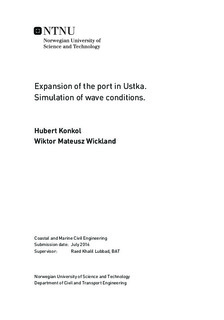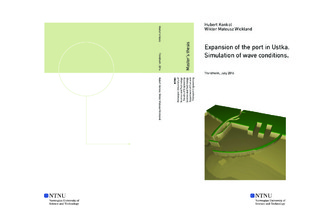| dc.description.abstract | Along with the development of port cities and conducting new market research and analysis it often turns out that the current port infrastructure is insufficient to exploit the full potential of the location. Then a modernization and expansion of the current port is needed. This is also the case of Port in Ustka, Poland, which is a small harbour handling mainly small fishing boats and yachts. With the ensuing need for a port being able to handle larger vessels, such as military units or vessels used during the construction and service of offshore wind farms, a decision for the port expansion has been made.
Designing a new harbour or a harbour expansion is always a very complex task, where a vast variety of complex phenomena and aspects have to be taken into account. One has to consider such aspect as technical requirements, environmental impact and financial feasibility and cost effectiveness of such an investment.
The research carried out in this thesis aims to choose the best harbour layout of new Harbour of Ustka out of four concepts provided by Maritime Office in Słupsk. As the decisive criterion wave climate inside the designed harbour was chosen. The best breakwater layout should ensure waves as small as possible in order not to disturb berthing of vessels and cargo handling operations inside the port. Wave propagation towards and inside harbour was modelled using MIKE 21 - numerical software developed by DHI. It is comprehensive tool containing numerous models and toolboxes that help to prepare all input data needed for the simulation. It includes also a module called MIKE C-MAP that contains global bathymetry and tidal data. As scarce data on waves and tides is available in the nearest proximity of the site of interest, the nesting approach has been used. Firstly, using all available information Spectral Wave model was prepared. It is a phase averaging model, that calculates wave statistics and allows for wave calculations in large scale. It was used to obtain reliable information about wave climate near the harbour of Ustka. Period of two months, January and February, was simulated, as major and most severe storms occur in this time. Output from Spectral Wave simulation was used to determine the input condition for a models prepared in much greater resolution. The four proposed breakwater layouts were tested using Boussinesq Wave models. Boussinesq Wave model is a phase resolving model, commonly used to investigate wave propagation and transformation in coastal area and wave interaction with the structures, as it is capable of resolving such wave phenomena as diffraction, refraction and reflection. Every layout was tested against waves coming from main direction, which is north-west, and most unfavourable direction of incoming waves, that is north-east.
After successful completion of numerical calculation, the results were summarized, compared and discussed. Conducted analysis allowed for choosing the best proposed breakwater layout in terms of provided wave conditions inside harbour basins and at the entrance to the harbour. In conclusion, limitations of the prepared models are listed, and ways of improvement are suggested. What is more a scope of future research is outlined. | |

